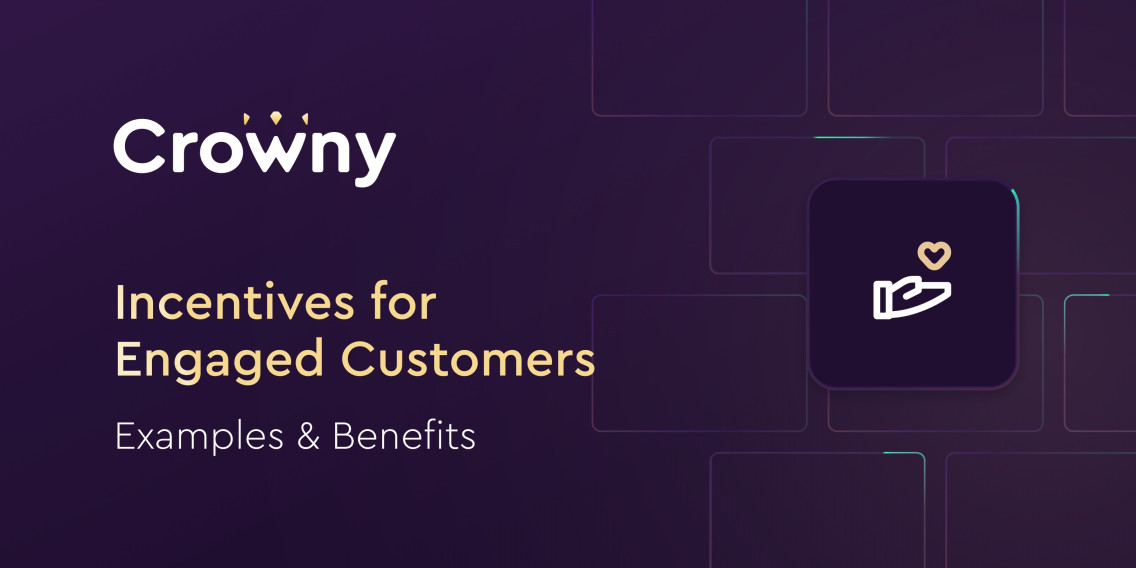Providing enticing incentives for engaged customers is easier said than done. Find out examples of customer incentives that you’ve rarely seen before.
Table of contents:
✅ Why customer incentives are crucial today
✅ What is an incentive program?
✅ Traditional benefits
✅ Examples of incentives
✅ Interaction-driven loyalty rewards
✅ Introducing ‘interact-to-earn’
✅ Blockchain-based loyalty rewards
Why customer incentives are crucial today
Customer loyalty is no longer a given for businesses. It’s now an ongoing battle. There are always competitors just waiting to take your customers with their products and services. And those other businesses can also provide incentives for engaged customers. They will do what it takes to get your customers. That’s why every business should constantly look for new ways to incentivize their customers so they keep returning for repeat purchases. It doesn’t matter what kind of business you have or the products you sell; there are multiple incentives you can use to boost customer engagement and retention.
55% of US and UK consumers say they trust brands less than they did in the past (Hubspot)
What is an incentive program?
An incentive program is a system that stimulates a target audience to perform desired (set of) actions. An incentive program can provide incentives for engaged customers so they keep coming back for more. Organizations can use an incentive program to encourage employees to engage with customers in a specific way. An incentive program can also be used for employees exclusively so they are motivated to perform better while working on their tasks. You can read more about the differences in this article.
Traditional benefits of incentives for engaged customers
So, incentives for engaged customers are generally offered through a consumer rewards program. Such programs come with various results once they are correctly implemented, and communicated well to the target audience. You could think of a positive brand image, increased customer lifetime values, sustainable brand loyalty, and long-term revenue growth. The incentives themselves come with a set of their benefits:
☑️ Stronger relationships
Customers that receive incentives are more likely to feel connected to your brand. Their loyalty is rewarded and they want to continue engaging with you.
☑️ More referrals
When a customer receives an incentive for referring their friends to you, they are more likely to do so. It is especially true if the incentive is immediate. Word-of-mouth marketing is one of the most powerful marketing tools, and this is the way to leverage that.
☑️ More upfront sales
With the help of incentives, you can get customers to open their wallets as soon as they find out about your business. It helps you meet your sales goals sooner.
☑️ Higher scoring reviews
Having good reviews for your business is an essential element of social proof that any business needs nowadays to get more conversions. Having satisfied customers isn’t enough, as they need to be incentivized to spread the good word about your business.
☑️ Increased amount of upsells
Customer satisfaction incentives are important to motivate existing customers to spend more with your business. One of the incentives for engaged customers could be a bonus for upgrading to a better subscription plan, for example.
☑️ Consistent user-generated content
Besides having customers refer your businesses to friends and family, they could also be incentivized to do this more publicly. When customers talk positively about your brand on social media, for example, this is called user-generated content.
81% of that same group (previously mentioned 55%) trusts product advice from friends and family over brand messaging, 71% don’t trust sponsored social media posts, and 65% don’t trust traditional advertisements. (Hubspot)
Examples of incentives for engaged customers
Traditional customer incentives are common. Most successful businesses recognize the value of these types of incentives for engaged customers. Here are a few examples:
☑️ 10% off their order
Discounts are a very common incentive, and you can use it on a one-time basis anytime you want. It works especially well when your business is slow in the middle of the year, like back-to-school or Christmas.
☑️ Free shipping
A well-known incentive that all consumers enjoy, especially online. It doesn’t cost your business a lot extra, but it’s a nice touch that your customers will appreciate.
☑️ Free return policy
Letting customers know they can return the items they buy from you without any hassle is another nice incentive to have. It helps you build trust with your customers and encourages them to buy from you again.
☑️ Free trial periods
A popular incentive for subscription-based services. This allows you to convince potential customers to try your product or service before committing to a long-term contract.
☑️ Prize draws/raffles
This is a fun way to incentivize your customers. You can host it at specific times of the year or whenever you want.
☑️ Loyalty rewards
Incentivizing your most loyal customers with points, discounts, or special gift cards can be a great way to keep them coming back for more.
Find out more loyalty program benefits that can drive revenue for your business.
Interaction-driven loyalty rewards
The examples of traditional incentives mentioned above are still relevant but are getting a little boring. Incentives for engaged customers were meant to generate certain results, with diversification from competitors as an example. But when a lot of businesses are using something, you won’t be able to distinguish yourself as a special brand anymore. Besides that, customers nowadays are generating more value for businesses than before. User-generated content and the provision of consumer data as two mere examples. For consumers to feel truly appreciated, engagement with brands should always be rewarded. To get to that point, businesses need to have their omnichannel marketing strategy streamlined for their (potential) customers to have a seamless user experience.
Companies that prioritized omnichannel customer engagement saw 9.5% year-over-year average growth, compared to 3.4% for companies that did not (Mad Mobile)
Introducing ‘interact-to-earn’ as new incentives for engaged customers
Interact-to-earn is a new model in the customer loyalty & marketing industries, inspired by the disrupting Web3 that aims to democratize value for the people. To read more about our latest Web3 development, click here. On Crowny’s platform interactive content campaigns, such as one-click reviews, are launched in the mobile app. The receiver of the push notification receives a small reward for interacting with the content, resulting in a higher clickthrough rate and positive brand perception. Businesses allow their community to earn crypto and their branded loyalty points, which can be seen as the most relevant direct incentives for engaged customers. With interact-to-earn, brands combine content marketing with a rewards system. This enables increased quality interactions with online communities that are receptive to the messaging and willing to engage. More on the interact-to-earn model (like a comparison with a similar model) can be found in this article.
Blockchain-based loyalty rewards
Blockchain technology is used to build many different applications. An industry where it has the potential to excel is the loyalty rewards space. For example, one of the biggest challenges with loyalty rewards is building trust and maintaining privacy. Blockchain technology is well suited to overcome these challenges as it’s a distributed ledger that is resistant to fraud. Another example is that blockchain-based rewards allow brands to provide incentives for engaged customers efficiently, fast, safely, and sustainably. Using tokenized economies built on blockchain technology, the low costs and limitless scalability of the model ensure a future-proof solution for any business. More advantages of blockchain-based loyalty rewards are:
☑️ More (non-intrusive) data tracking opportunities
☑️ Additional options to incentivize (staking, etc)
☑️ Highly secure transactional network
There are many more advantages of blockchain-based loyalty rewards.
Check them out in this article.
Final words
The customer relationship is ever-evolving, and brands must adapt to stay relevant in their customers’ minds. Implementing blockchain in loyalty and marketing strategies is a development that is still very immature, but early adopters can still benefit from it in massive proportions. The way to do this is with an effective incentive program tailored to engage your customers, retain them over time, and encourage them to spend more. Customer engagement is the key to long-term business success, so it’s important to keep your customers satisfied. Crowny can help, as we are launching our platform very soon.
Get early access to schedule a demo now.

